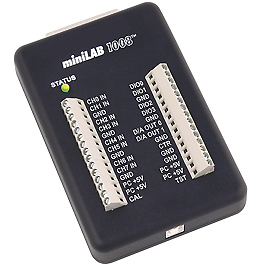Key Highlights
- 8 single-ended or 4 differential analog inputs
- Two 10-bit analog outputs
- 28 bi-directional digital I/O lines
- One 32-bit external event counter
- 12-bit (DI), 11-bit (SE) resolution

The miniLAB 1008 is a USB-based multifunction data acquisition (DAQ) device.
Key Highlights
| 
|
The miniLAB 1008 features eight 12-bit analog input signal connections and 28 digital I/O connections. It is powered by the +5 volt USB supply. No external power is required.
Two screw terminals rows provide connections for eight analog inputs, two 10-bit analog outputs, four bidirectional digital I/O lines, and one 32-bit external event counter. You can configure the analog input connections with software as either eight single-ended or four differential channels. All analog connections terminate at the screw terminals.
24 bidirectional digital I/O lines are also available on a 37-pin connector.
An on-board industry standard 82C55 programmable peripheral interface chip provides 24 digital I/O lines that terminate at a 37-pin connector.

A low-noise precision programmable gain amplifier (PGA) is available on differential channels to provide gains of up to 20 in the following ranges:
±20 V ±10 V ±5 V ±4 V ±2.5 V ±2 V ±1.25 V ±1 V
In differential mode, the following two requirements must be met for linear operation:
In continuous scan mode, the miniLAB 1008 gathers data in a single-channel or multi-channel sequence. This sequence converts, transfers, and stores data to a user buffer until the scan is stopped. In this mode, digitized data is continuously written to an on-board FIFO buffer. This FIFO is serviced in blocks as the data is transferred from the miniLAB 1008 to the user buffer in the host PC.
The maximum continuous scan rate of 1.2 kS/s is an aggregate rate. The total acquisition rate for all channels cannot exceed 1.2 kS/s. You can acquire data from one channel at 1.2 kS/s, two channels at 600 S/s and four channels at 300 S/s. You can start a continuous scan with either a software command or with an external hardware trigger event.
In burst scan mode, the miniLAB 1008 gathers data using the full capacity of its 4 K sample FIFO buffer. You can initiate a single acquisition sequence of one, two, or four channels by either a software command or an external hardware trigger. The captured data is then read from the FIFO and transferred to a user buffer in the host PC.
Since the data is acquired at a rate faster than it can be transferred to the host, burst scans are limited to the depth of the on-board memory. As with continuous mode, the maximum sampling rate is an aggregate rate. Consequently, the maximum burst mode rates are 8 kS/s, 4 kS/s and 2 kS/s for one, two and four channels, respectively.
There are two channels of analog output, using a PWM 10-bit D/A converter. The output voltage range is 0 – 5 volts. The sample rate is 100 S/s (single channel) and 50 S/S (dual channel). The typical slew rate is 0.14 V/mS.
MATLAB supports a variety of data acquisition systems in the Data Acquisition Toolbox. To perform any task with your data acquisition application, you must call M-file functions from the MATLAB environment. Among other things, these functions allow you to:
Data Sheet (PDF)
User's Manual (PDF)
Maintained by John Loomis, last updated 11 April 2009